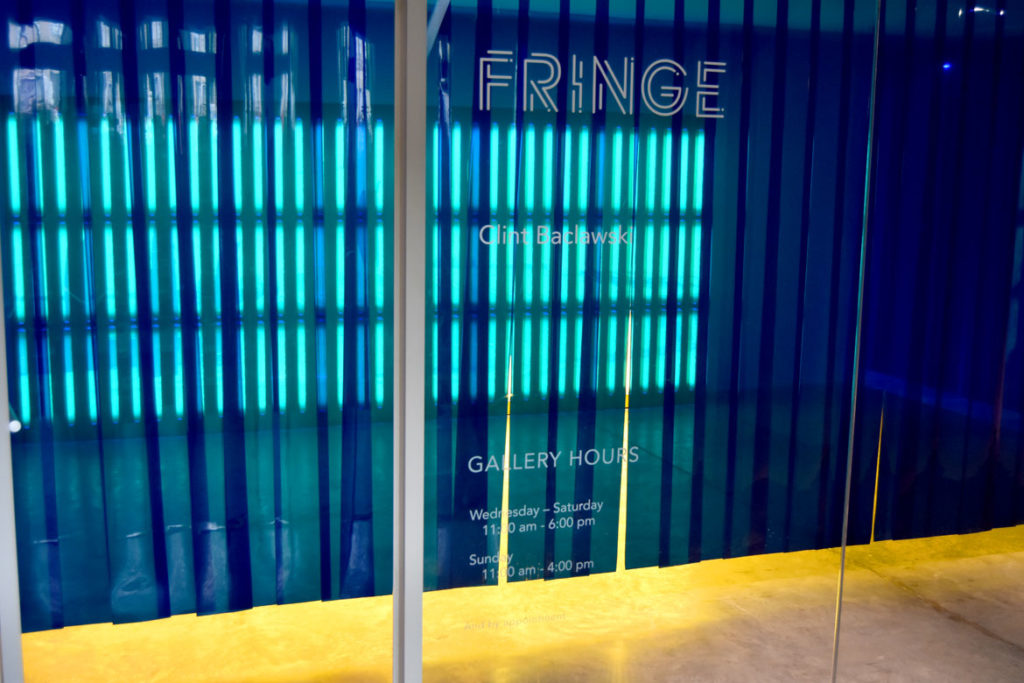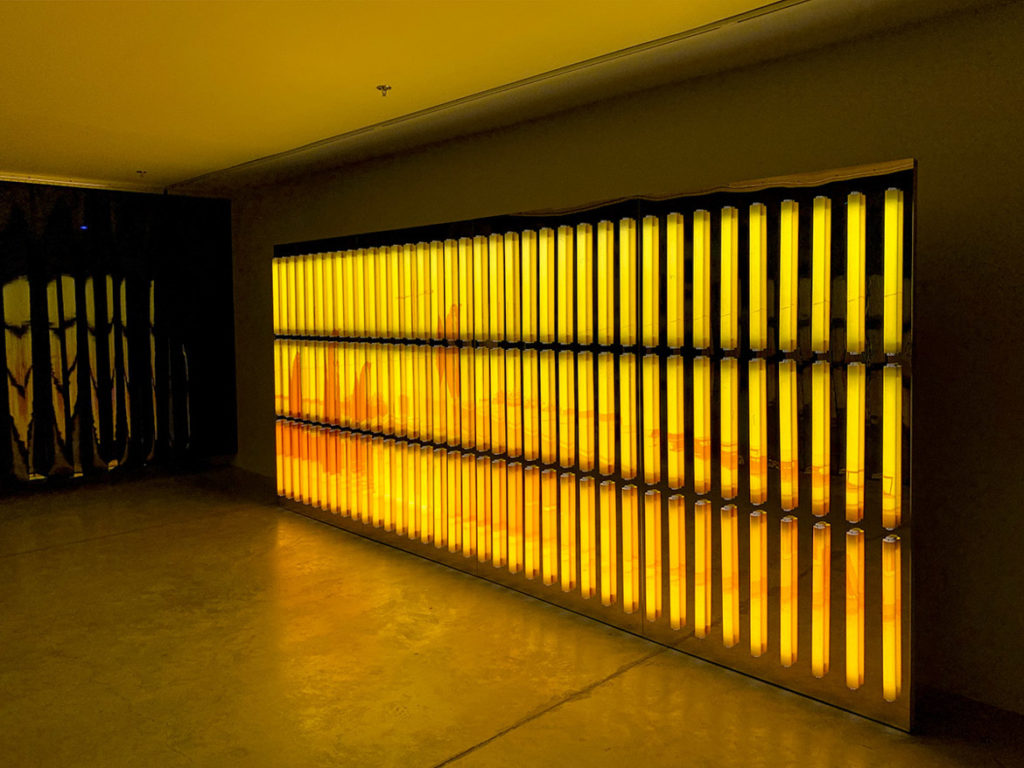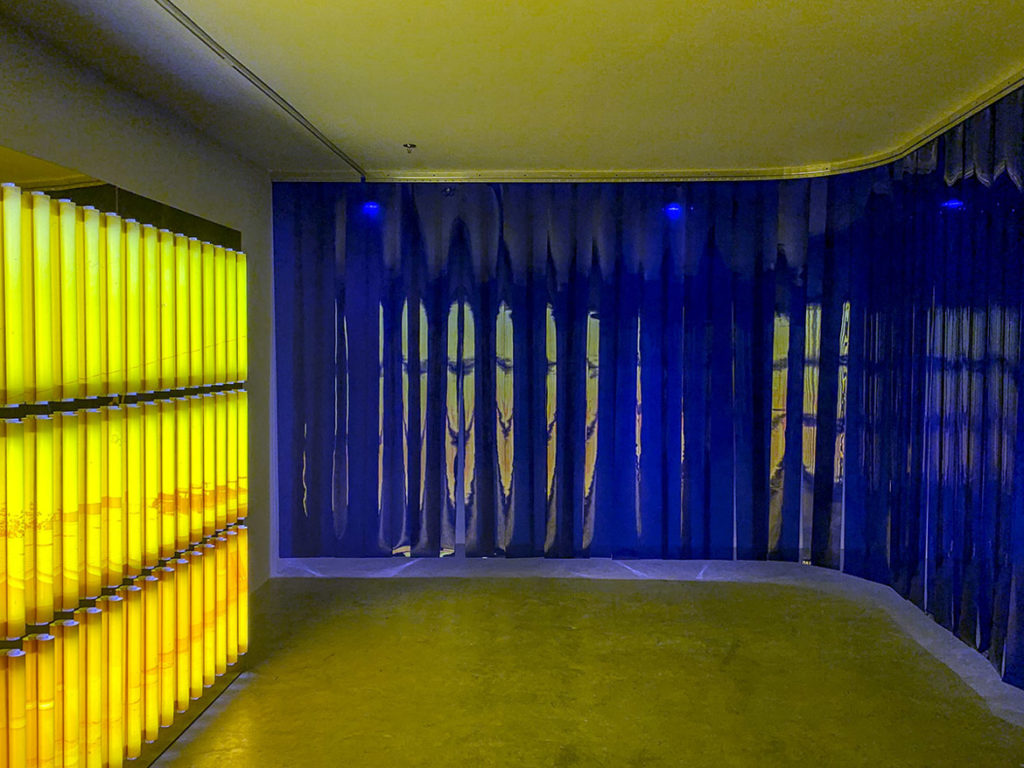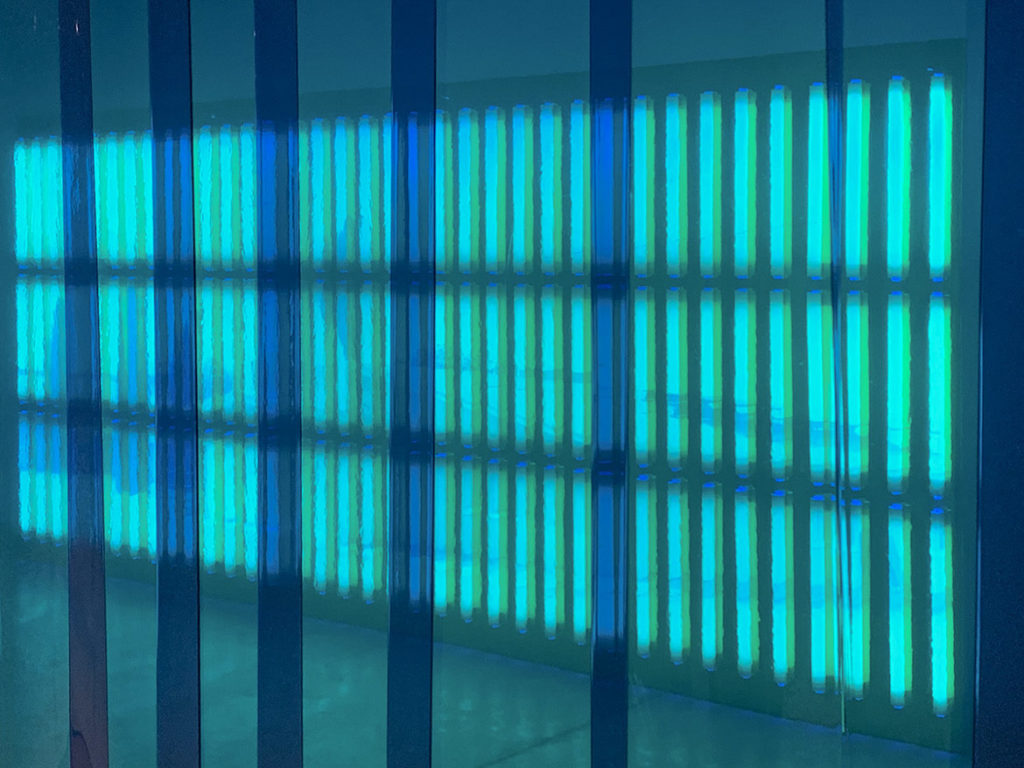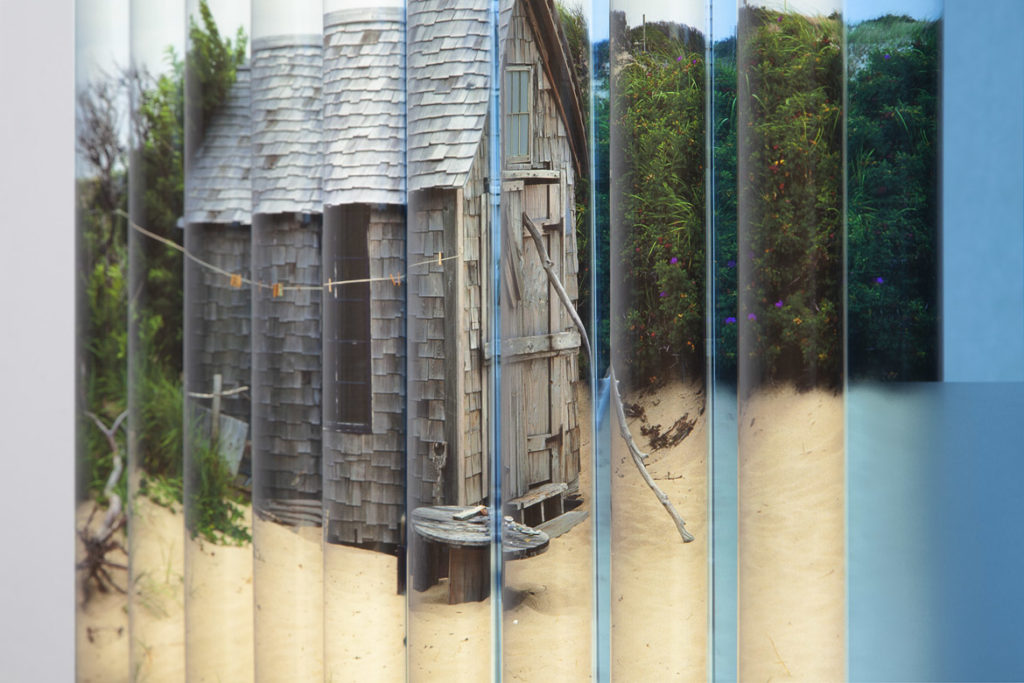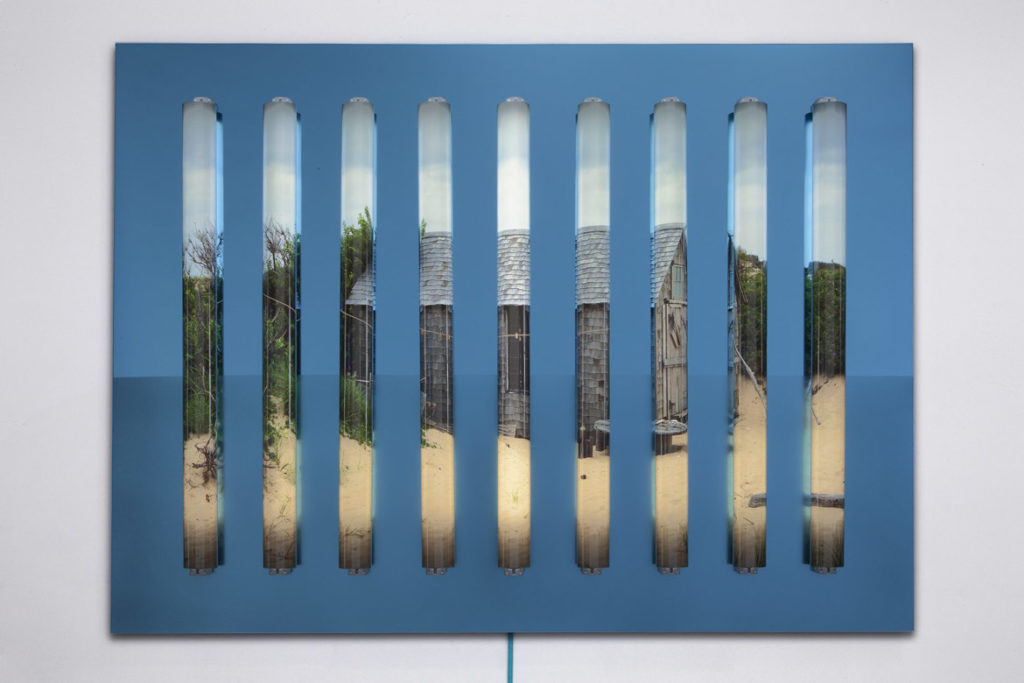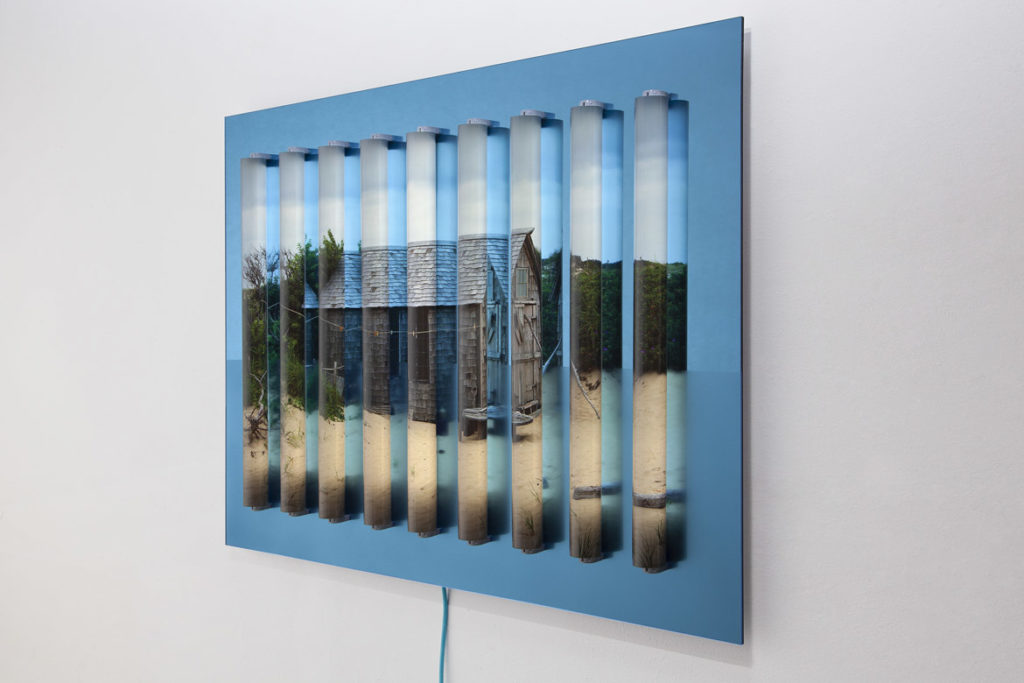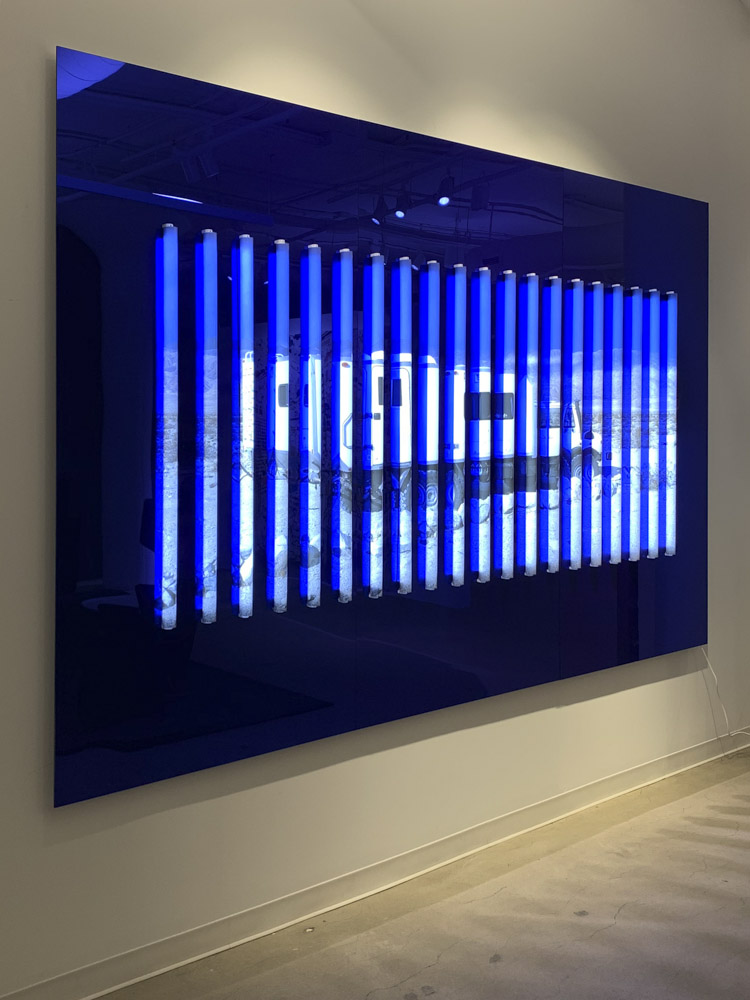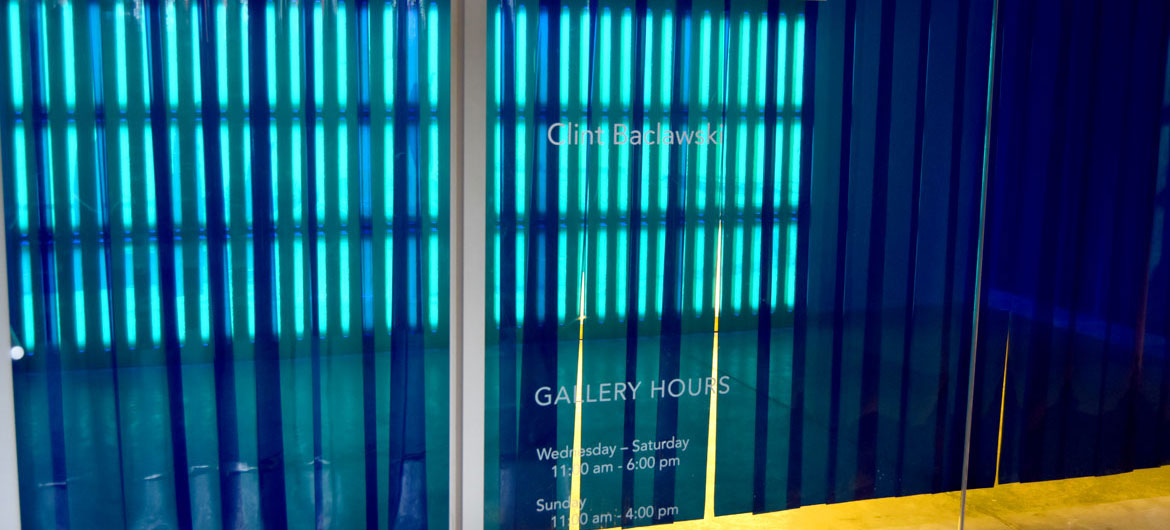A band of lights glows behind the translucent blue plastic curtain of Clint Baclawski’s latest artwork, “Fringe” at Abigail Ogilvy Gallery in Boston from Sep. 6 to Oct. 13, 2019. Yellow spills out from underneath the curtain strips, material used in welding shops to protect eyes.
Light, the Malden artist says, is “an innate thing to be attracted to. Like a moth to a flame. …. You want to kind of go in and explore this piece.” Then “You are quite literally blinded when you first go through until your eyes adjust a little. … I didn’t know how much of a shock it would be to your eyes until I assembled it.”
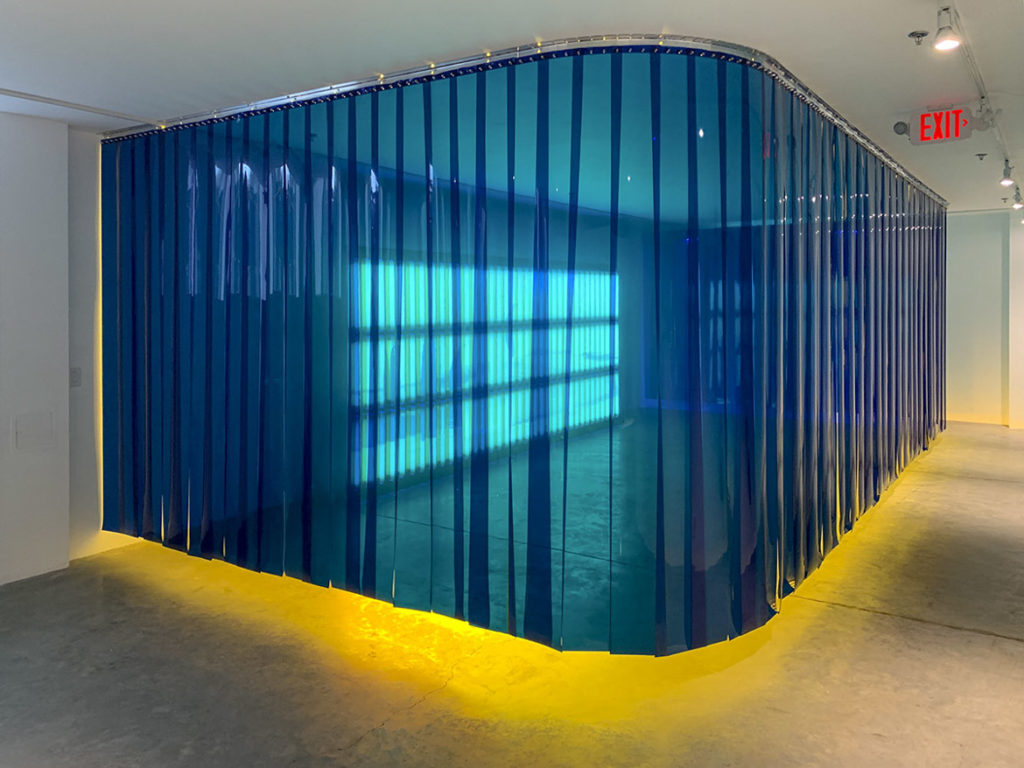
Behind the curtain is one of Baclawski’s “light bulb pieces”—a photo transparency sliced into vertical strips and each one wrapped around a long, lit LED bulb, which are displayed in a row. The cutting disrupts the image, which can make it hard to decipher. Often it’s not until you walk to the side, catching it at an angle, that your eyes begin to reassemble it into a view of a “souped-up RV” he spotted in Death Valley or a house boat outside Joshua Tree National Park or a porch left behind when an RV that’s moved on.
“It really does disappear in front of you,” he says. “Then it kind of comes together again when you see it on the other side or come back to that first angle.”
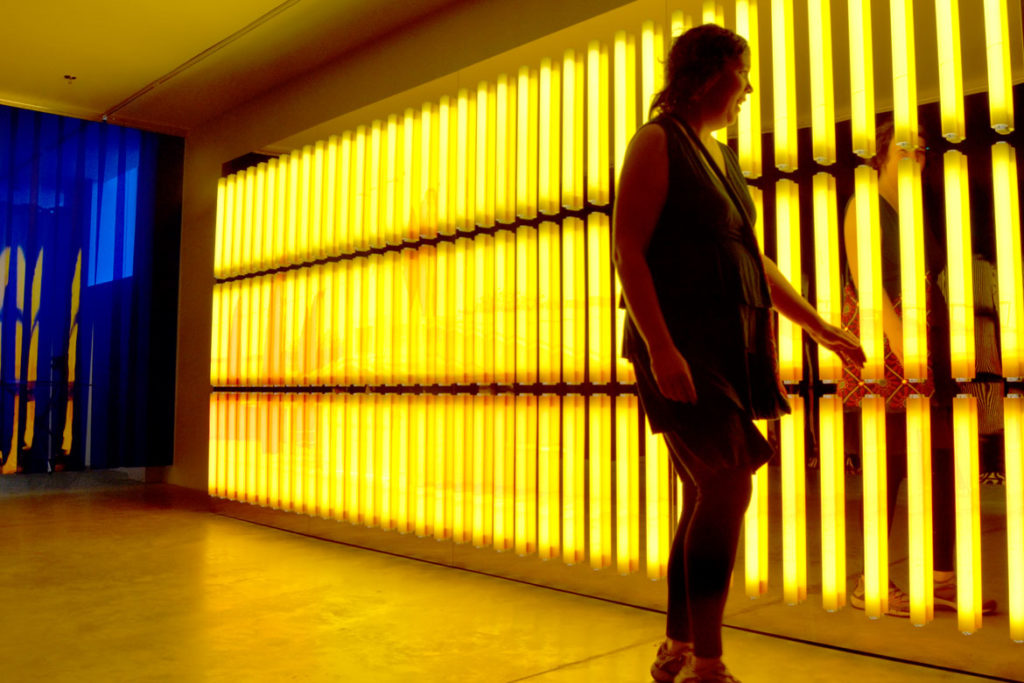
In “Fringe,” the photo comes from a 2011 adventure. “I was traveling to the Grand Canyon to photograph the Skywalk, which I had used in an earlier light box piece,” Baclawski recalls. He was driving alone in a rented car, along dirt and gravel roads of the Hualapai tribe reservation. “These are my favorite types of trips. You get to fully focus on making the pictures you want to. It’s primarily a solitary act.”
“I saw this pink church. It stood out to me right away and I pulled over and shot it,” Baclawski says. Another photo from this shoot became his “Pink Church” light bulbs piece from five years ago. He was photographing with 4×5 film and a Horseman camera that he’s used for a decade and a half. (Recently, he switched to an 8×10 film camera.) “I always shoot multiple frames. I don’t usually move the tripod. I need to make sure the exposure is dead on.”
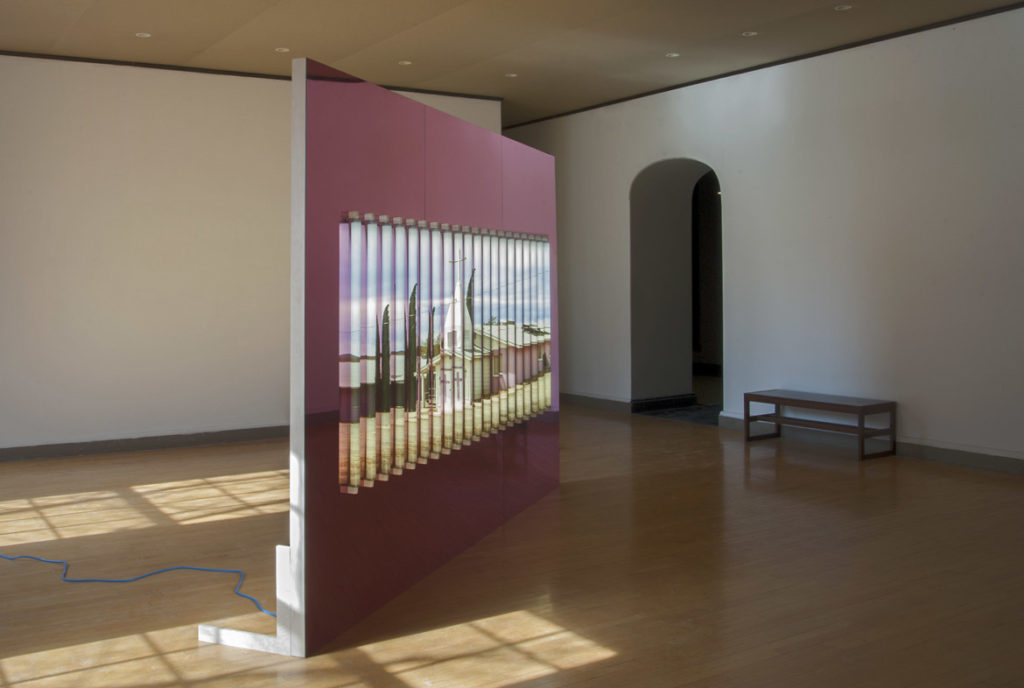
As he was flying back home, Los Angeles airport security opened up his film case. “Fringe” uses the sheet of film most damaged. “The top sheet of that film was the one that got hit with the blue light,” Baclawski says. “My film being opened, that produced a level of dust that I’ve never seen before.”
“Dust is the enemy,” Baclawski notes. At least usually. So it’s generally his practice to clean up his photos digitally, to remove every speck of grime. But not this time. This time he showcases the overexposure and the dust. You might say it’s about trying to accept the things you cannot change.
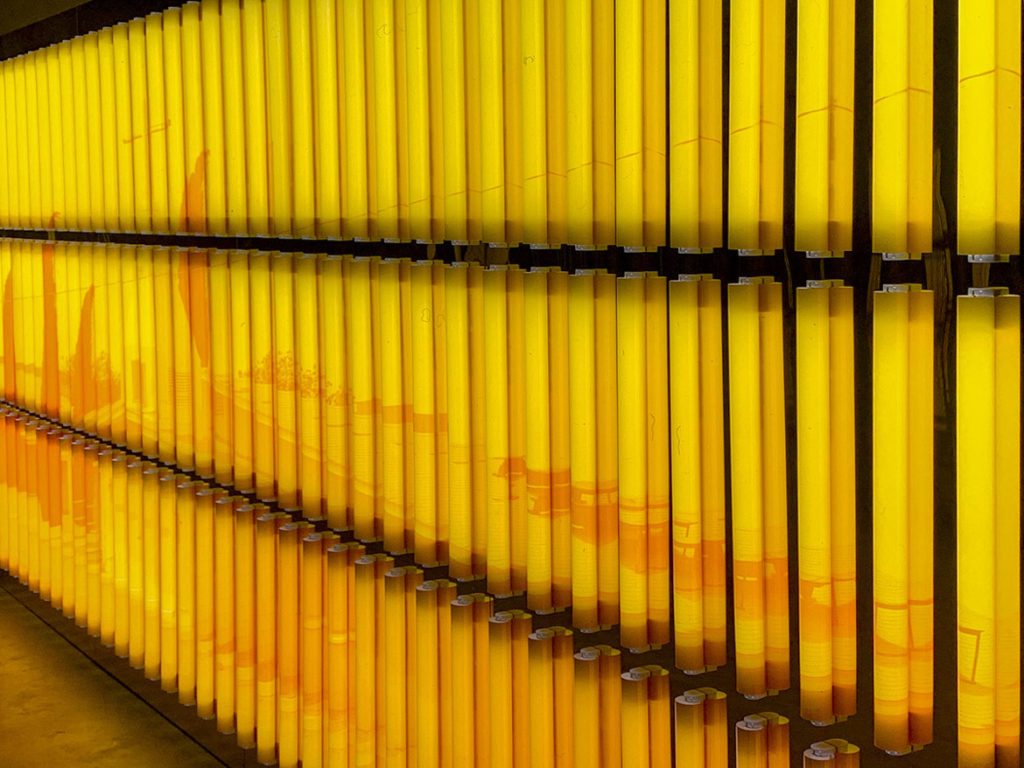
“The second iteration of ‘Pink Church’ has taken a more personal turn for me. I’ve been kind of dancing around this idea of the church as images of Christ in my photographs for a long time,” Baclawski says. “This piece for me is about the idea of recovery. On a personal level, it’s about recovery from drugs”—”a lot of psychedelics,” though he notes, “I am not sure I was ever chemically dependent on them. I was however smoking a lot of weed and drinking frequently.”
He says, “I’ve been clean for a long time. To a point where I feel the two roads that I’ve straddled—this road of recovery and this road of artistic photography—are merging with this piece. I don’t know if this comes across to the viewer.”
“I’ve been in recovery for 18 years. I no longer believe in organized religion. And yet, I seek some sort of spirituality through these road trips I take—the quietness that you might find by yourself,” Baclawski says. “Through the process of rediscovering what I want in life.”
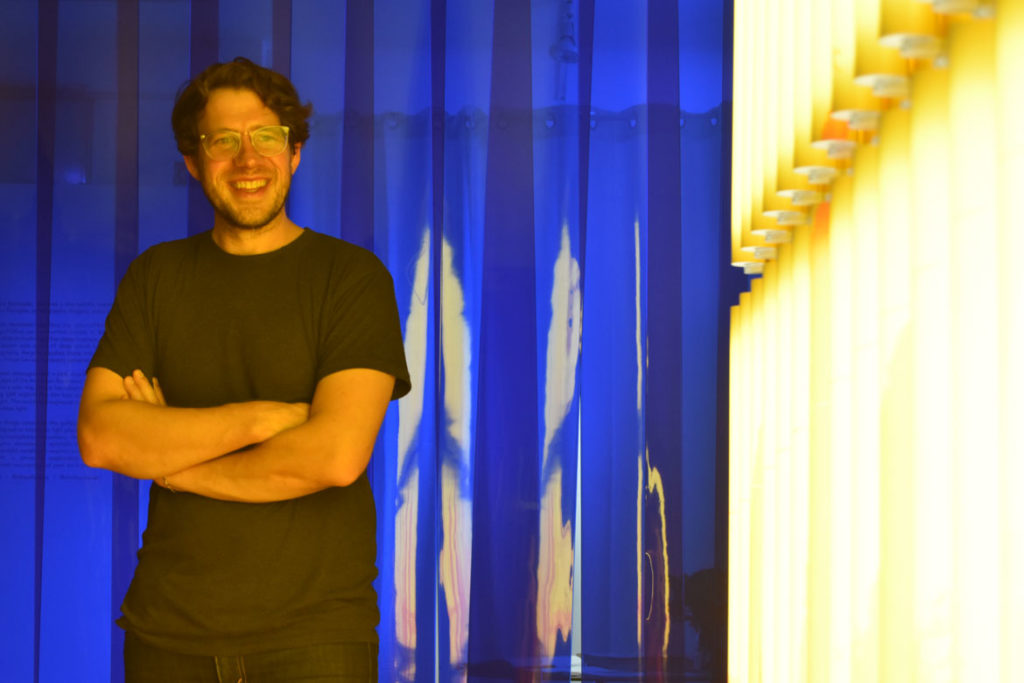
The Glow Of Advertising
Clint Baclawski grew up in Williamsport, Pennsylvania. He majored in advertising photography at Rochester Institute of Technology in New York State to learn camera formats and lighting. He was required to photograph with 4×5 chrome (or slide) film. “Most of my critiques were on a light table,” he recalls. He was entranced by the lusciousness of the film, by the glow of the lights. “I fell in love with that back-lit image on chrome.”
Baclawski worked a couple summers at Mount Hood in Oregon, photographing “snowboarders on an arctic volcano for a couple of snowboard camps,” Baclawski says. “I really quickly learned that I didn’t want to do that kind of photography.” He’s long loved skiing and snowboarding, but didn’t feel at home among the bro community and their all night partying. “I didn’t want to be just a lifestyle photographer. I knew at that point that I wanted to switch trajectories.”
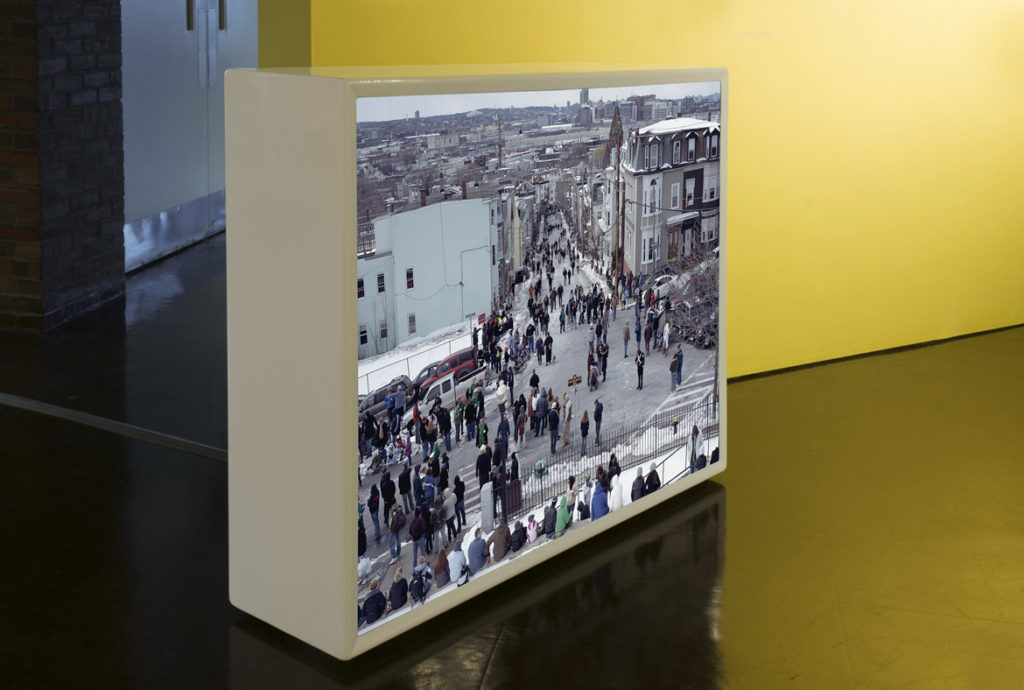
He went on to study photography at Massachusetts College of Art + Design in Boston, from which he earned a master’s degree in photography in 2008. There he began constructing light box pieces—steel boxes, the size of a large suitcase, with a pair of photo transparencies filling the two larger sides of each box. The images were back-lit by lights inside.
“The image appeared to be the same [on both sides], but on the opposing side, the image was inverted horizontally. … There was this disorienting thing that would occur when you walked around the piece,” Baclawski says. “I’m an identical twin. I was playing with the mirroring of that.”
“It’s really set up for me to be about advertising,” he says. “The presentation of the light bulb beckons back to the dying age of the back-lit billboard display.”
“The light box series was about the spectacle—as many people, as many crowds as I could crowd into that frame,” Baclawski says. Convention halls, the St. Patrick’s Day Parade in South Boston, Macy’s Thanksgiving Day Parade in New York, the glass-floored Skywalk that juts 70 feet out over the Grand Canyon, an inflatable sinking Titanic in a gym at Bucknell University in Pennsylvania during a staff event. “I loved how the color of the gymnasium played off he colors of the school. … There were a lot of specks of orange.”
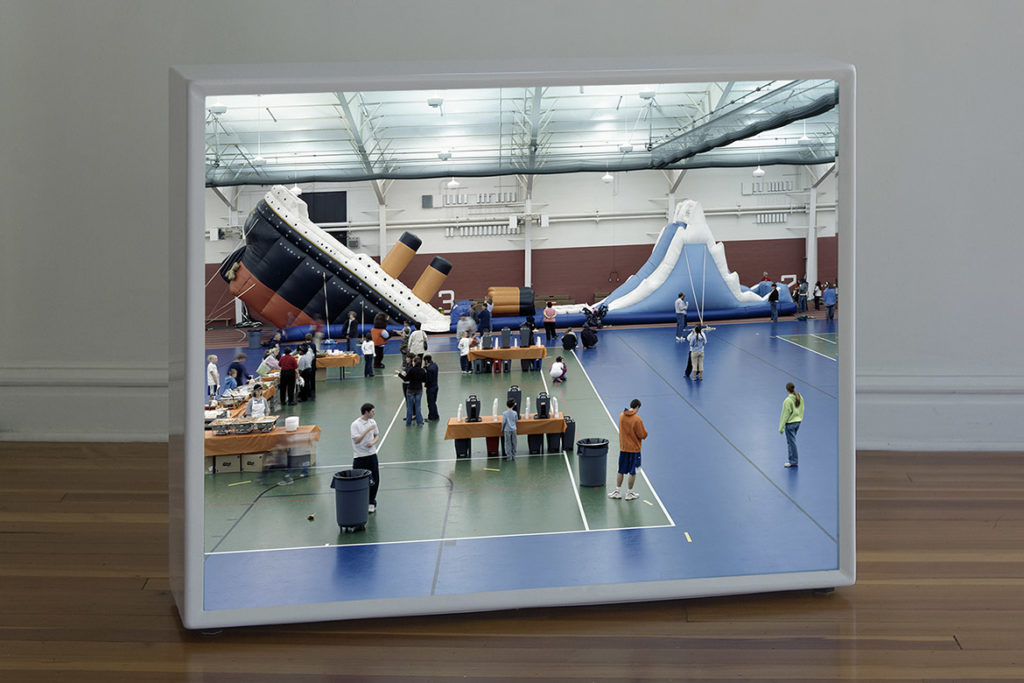
Light Bulbs
Baclawksi is a hands-on artist, enjoying working on all the careful details and construction and wiring that goes into crafting his artworks.
He was tweaking some micro-controllers that would dim the light bulbs inside one of the light boxes when “a print fell off the table that I was working on. It was a large print, 40×50 [inches]. It draped over one of the bulbs and that gave me an idea that I could take a print and wrap it about the bulbs,” Baclawski says. “It was like a literal light bulb moment.”

In 2014, he exhibited the first one at the Hallway gallery in Boston’s Jamaica Plain neighborhood. It was a quirky, charismatic little gallery running the length of a 6-foot-wide hallway. Baclawski’s glowing 8-foot-tall, 30-foot-long artwork filled it. The narrow space kept you close to the artwork, and prompted you to look along its length, where the sliced-up photo coalesced into a full image—a view of sidewalk, fence and a tree from the porch of the home he had in Boston’s Jamaica Plain neighborhood.
“I was elated. Technically, I was still working with fluorescents. I still didn’t technically understand what was going on,” Baclawski. He was learning how to wire all the bulbs, so many bulbs. “When the opening came I was just elated it was done.”
“The color was so rich that I got from that backlight fill,” he recalls. “It was the color and the surprise element when you first positioned yourself to get the full image.”

After the focus on spectacle and advertising with his light boxes, with these light bulb pieces, “I decided to go the opposite route, to show imagery that’s devoid of advertising,” Baclawski says. “I’d be looking for these off-the-grid places … that are completely removed from that world of advertising.”
He photographed wind turbines, snow-caked woods at Pine Banks Park in Melrose, an RV in Death Valley, a houseboat outside Joshua Tree National Park, one of the dune shacks along the Cape Cod National Sea Shore, a replica of Transcendentalist writer Henry David Thoreau’s cabin at Walden Pond in Concord. “To me, in nature, I think of Thoreau,” Baclawski says.
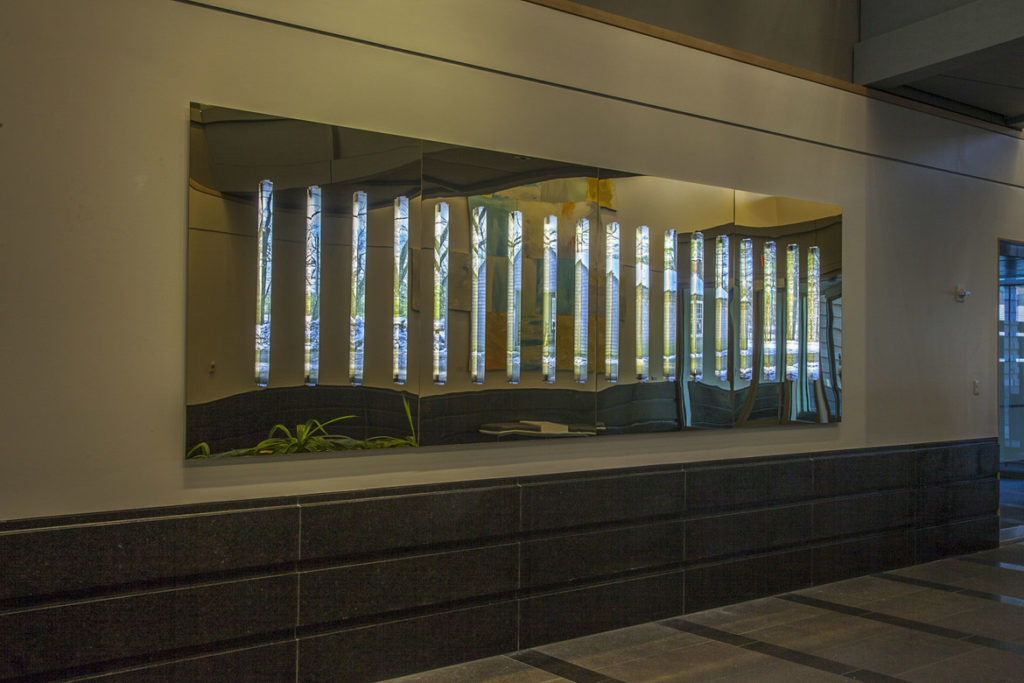

“I don’t have a destination,” Baclawski says. “The destination might be a national park. I’m more interested in what’s happening around the scenes or around these bucolic landscapes.”
“Fringe” features that pink church that caught his eye along the road to the Grand Canyon. You pull back the blue curtain’s plastic strips and enter into the yellow glow. Baclawski says, “You go towards the light. You’re blinded by the light. It’s dirty. … I’m leaving all the remnants of the process. There’s also this isolation. You could go behind the piece.”
He says, “It starts to play with this notion of recovery. You think there’s this pretty thing behind the curtain. But you often are left blinded by this image that’s hard to read, or you don’t make the most sense of it.”
“Fringe” finds Baclawski at a new fork in the road, where the thrill of the play of electric light and colored scrims encourages him to consider a path of immersive experiences. “It’s gone into a new realm of installation,” he says. “It really opens up the doors to me of possibilities.”
If this is the kind of coverage of arts, cultures and activisms you appreciate, please support Wonderland by contributing to Wonderland on Patreon. And sign up for our free, weekly newsletter so that you don’t miss any of our reporting.
